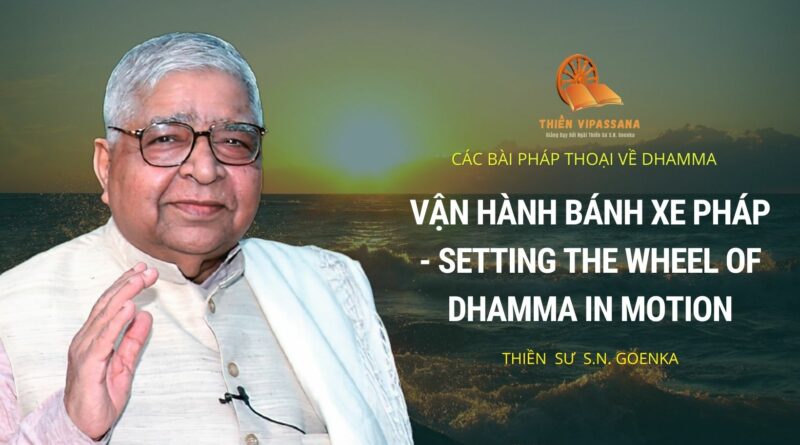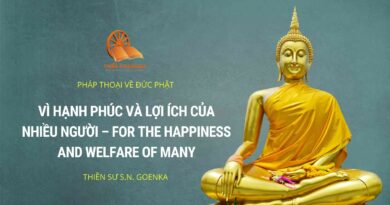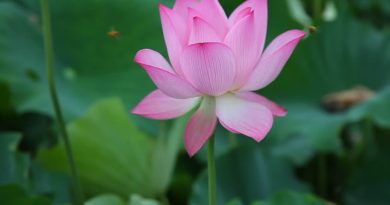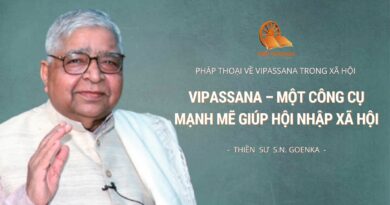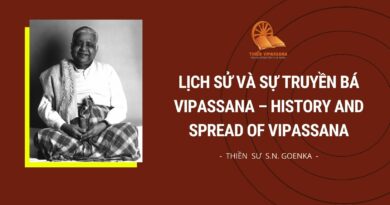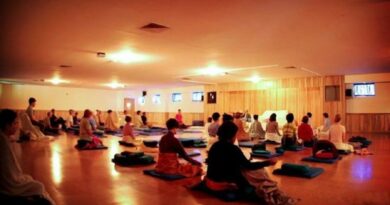Discourses of the Buddha – Setting the Wheel of Dhamma in Motion – Vận Hành Bánh Xe Pháp
(A Dhamma letter by Goenkaji dated July 15, 1968)
(Một bức thư Dhamma bởi Goenkaji 15 tháng 7 năm 1968)
Dear All,
Understand the essence of Dhamma and practice it. The auspicious day of Asādha-pūrnimā is as significant as vaisākha-pūrnimā – the day when the Bodhisattva Siddhārtha Gotama was born, the day he became Fully Enlightened and the day of his Mahā-parinirvāna (the passing away of a Sammasambuddha). Similarly, it was on this day of Āsādha-pūrnimā that the Bodhisattva left the Tusita Deva Realm to enter the womb of Mahāmāyā and the day he renounced life of the householder. This was also the day he set the wheel of Dhamma in motion. Let us discuss the importance of these three occasions in detail:
Thưa tất cả,
Hãy hiểu bản chất của Dhamma và thực hành nó.
Ngày tốt lành Asādha-pūrnimā cũng quan trọng như sākha-pūrnimā – ngày Bồ tát Siddhārtha Gotama ra đời, ngày Ngài trở nên giác ngộ hoàn toàn và ngày Mahā-parinirvāna của Ngài (sự qua đời của một Sammasambuddha – Bậc Chánh Đẳng Giác). Tương tự, cũng là ngày sādha-pūrnimā, ngày mà Bồ tát rời khỏi cõi Tusita Deva để tái sinh vào tử cung của hoàng hậu Mahāmāyā và ngày Ngài từ bỏ cuộc sống gia đình. Đây cũng là ngày Ngài khởi động bánh xe Dhamma. Hãy để chúng ta thảo luận về tầm quan trọng của ba dịp này một cách chi tiết:
1) The Time of Conception
This is as important as when the child is born. Both mind and matter are needed for life, and death occurs when these two are separated when the mind is separated, detached from the matter. Though the lifeless body disintegrates into the four elements, the mind continues. It directly attaches itself to another ‘rūpa’ (material form) or rūpakkhandha at the moment of conception – when new life begins by the combination of sperm and ovum. Even though actual birth takes place after about 9 or 10 months, new life begins at the moment of conception. According to the vinaya-piṭaka (the book of rules for monks), one can become a bhikkhu (monk) only on attaining 20 years of age. If one takes the robe before this, he will be known as a sāmanera (novice). The 20 years of age is calculated not from the time of birth, but from the time of conception. This shows the importance of the time of conception over the actual time of birth.
1) Thời Kỳ Thụ Thai
Sự kiện này quan trọng như ngày sinh ra. Cả tâm và vật chất đều cần thiết cho cuộc đời, và cái chết xảy ra khi cả hai tách nhau ra, khi tâm vị rời khỏi tách ra khỏi vật chất. Mặc dù cơ thể chết phân rã thành 4 thành phần, tâm vẫn tiếp tục. Nó trực tiếp gắn vào một ‘rūpa khác (dạng vật chất) hoặc rūpakkhandha tại thời điểm thụ thai – khi cuộc sống mới bắt đầu bằng sự kết hợp giữa tinh trùng và noãn. Mặc dù việc sinh nở thực sự diễn ra sau khoảng 9 hoặc 10 tháng, cuộc sống mới bắt đầu vào thời điểm thụ thai. Theo vinaya-piṭaka (sách qui tắc cho tu sĩ), người ta có thể trở thành một Tỳ kheo (tu sĩ) chỉ khi đạt 20 tuổi. Nếu một người lấy áo choàng ( xuất gia) trước đó, anh ta sẽ được gọi là sāmanera (người mới). 20 tuổi được tính không phải từ lúc sinh, mà là từ lúc thụ thai. Điều này cho thấy tầm quan trọng của thời gian thụ thai so với thời gian sinh thực tế.
In spite of beliefs of different philosophies, the reality is that mind-matter continuously arises and passes away. Every moment the cycle of life and death goes on. But yes, if the mind at the moment of death (patisandhi) is so pure that it is born in the arūpa-brahmaloka, then it does not need physical matter to continue. In such a realm, only the mind aggregates remain. It is a matter-less state of existence. But in all the other planes of existence – rūpa-brahmas, devas, humans, birds, animals, reptiles, petas, asuras, and those born in hells – the physical matter (rūpa) is necessary for existence.
Mặc dù niềm tin của các triết lý khác nhau, nhưng thực tế là các vấn đề của tâm liên tục sinh ra và diệt đi. Mỗi khoảnh khắc của vòng tuần hoàn sự sống và cái chết vấn tiếp diễn. Nhưng nếu tâm tại thời điểm chết (patisandhi) thuần khiết đến mức nó được sinh ra trong arūpa-brahmaloka ( cõi phạm thiên), thì nó không cần vật chất để tiếp tục. Trong một cảnh giới như vậy, chỉ còn các tập hợp tâm trí còn lại. Đó là một trạng thái ít tồn tại. Nhưng trong tất cả các cõi giới còn lại – phạm thiên, con người, chim, động vật, bò sát, petas, asura và những người sinh ra trong địa ngục – vật chất (rūpa) là cần thiết cho sự tồn tại.
The mind continuum cannot exist or wander around without physical matter. For example, if it takes birth as a peta (a form of ghost), it has to instantly connect with subtle physical matter of the peta realm. Likewise, beings born in the womb are conceived in the womb. For other beings, the mind continuum attaches immediately to physical matter in a plane of existence depending on the nature of mind at the moment of death. This physical structure or body could be solid like those of humans, birds and animals, etc., or subtle as those of asuras, petas, devas or brahmas. But a physical body is necessary. The mind continuum cannot keep wandering in these realms without a body. At the moment of death, the mind continuum connects with matter somewhere else. This connection of mind with matter makes a new life.
Tâm liên tục không thể tồn tại hay đi lang thang mà không có vật chất. Ví dụ, nếu nó sinh ra dưới dạng peta ( ngạ quỷ), nó phải kết nối ngay lập với vật chất vi tế của cõi peta. Cũng vậy, những sinh vật sinh ra từ tử cung thì thụ thai nhờ tử cung. Với các chúng sinh khác, tâm liên tục gắn ngay lập tức với vật chất ở cói giới tồn tại phụ thuộc vào trạng thái tự nhiên của tâm lúc chết. Cấu trúc vật lý này hay cơ thể có thể rắn như con người, chim, động vật.. hay tinh vi như a atula, ngạ quỷ hay phạm thiên. Nhưng một cơ thể vật lý là cần thiết. Tâm liên tục không thể cứ lang thang trong những cõi này mà không có thân xác. Tại thời điểm của cái chết, tâm liên tục kết nối với vật chất ở một nơi khác. Sự kết nối tâm trí này với vật chất tạo nên một cuộc sống mới.
It is noteworthy that one is ‘born’ three times – at the moment of conception, when being delivered from the womb, and when one takes Dhamma birth with the practice of Vipassana, by tearing open the veil of ignorance. Hence, just as the day of the birth of the Bodhisattva Gotama, and the day when he became Fully Enlightened are important, so too the time of his conception is also important
Điều đáng chú ý là một người được sinh ra 3 lần: tại thời điểm thụ thai, khi chui ra khỏi bụng mẹ và một người được sinh ra một lần nữa khi thấy ánh sáng của Dhamma -bằng cách thực hành Vipassana và xé toang màn vô minh. Do đó, cũng giống như ngày sinh của Bồ tát Gotama và ngày Ngài trở nên giác ngộ hoàn toàn rất quan trọng, vì vậy thời gian thụ thai của Ngài cũng rất quan trọng.
2) The Day of the Bodhisattva’s Renunciation
Āsādha-pūrnimā is also of great importance, as on this day Prince Siddhārtha left the householder’s life in search of Enlightenment. It is in this going forth that the seed of enlightenment was sown. He could not have become a Buddha by staying at home and enjoying worldly pleasures. Prince Siddhārtha undertook hardships of the homeless life for the welfare of all beings. If he was only concerned about his own welfare, then he could have easily liberated himself, and become an Arahant four asankheya and 100,000 eons ago, during the days of Dīpankara Buddha. But it is impossible for a Bodhisattva to think only of his own welfare. Ready to face difficulties through innumerable lives, he undertook the task of fulfilling all ten pāramis to the extent needed to become a fully enlightened sammāsambuddha – and to serve for the liberation of countless beings. Now in his last birth, the time had ripened for the Bodhisattva to become fully enlightened. Hence this day of his going forth, for the benefit of many, is very auspicious.
2) Ngày Rời Bỏ Của Vị Bồ Tát
Āsādha-pūrnimā cũng có tầm quan trọng rất lớn, vì vào ngày này Hoàng tử Siddhārtha đã rời bỏ cuộc sống gia đình trong cuộc tìm kiếm sự giác ngộ. Chính trong điều này hạt giống giác ngộ đã được gieo. Ngài không thể trở thành một vị Phật bằng cách ở nhà và tận hưởng những thú vui trần tục. Hoàng tử Siddhārtha đã chấp nhận những khó khăn của cuộc sống không gia đình vì lợi ích của tất cả chúng sinh. Nếu Ngài chỉ quan tâm đến lợi lạc của chính mình, thì Ngài có thể dễ dàng tự giải thoát mình, và trở thành một vị A la hán bốn a tăng kỳ và 100.000 chu kỳ trước đây trong thời của Đức Phật Dīpankara. Nhưng vị Bồ tát đã không thể chỉ nghĩ đến phúc lợi của chính mình. Sẵn sàng đối mặt với khó khăn qua vô số kiếp, Ngài nhận nhiệm vụ hoàn thành tất cả mười pāramis đến mức cần thiết để trở thành một sammāsambuddha giác ngộ hoàn toàn – và phục vụ cho việc giải thoát vô số chúng sinh. Bây giờ trong lần sinh ra cuối cùng của mình, thời gian đã chín muồi để vị Bồ tát được giác ngộ hoàn toàn. Do đó ngày này Ngài ra đi vì lợi ích của nhiều người là ngày rất tốt lành.
3) Setting the Wheel of Dhamma in Motion
It was on this day that the Buddha set the Wheel of Dhamma in motion, for the benefit, happiness and liberation of countless beings. He gave his first discourse to the five ascetics, his former companions. The ascetic Gotama had become the Buddha by practicing Vipassana. All doubts, skepticism vanish when the laws of nature are experienced through practice of Vipassana. Likewise, the ascetic Gotama became Fully Enlightened and realized the law of cause and effect i.e. the chain of Dependent Origination. He realized the cause of misery, the way to eradicate that cause, to eradicate all impurities in the mind. Such a being of ultra-purity shines bright like the sun coming out from clouds.
3) Lăn Bánh Xe Dhamma (Vận Hành Bánh Xe Pháp)
Trong ngày này Đức Phật đã thiết lập chuyển động của bánh xe Dhamma vì lợi ích hạnh phúc và giải thoát của vô số chúng sinh. Ngài thực hiện bài giảng đầu tiên đến năm tu sĩ, những người bạn cũ của Ngài.
Tu sĩ Gotama đã trở thành Đức Phật bằng thực hành Vipassana. Tất cả những sự ngờ vực hoài nghi biến mất khi luật của tự nhiên được chứng nghiệm thông qua thực hành Vipassana. Cũng vậy, tu sĩ Gotama trở nên giác ngộ hoàn toàn và nhận ra luật nhân quả và chuỗi Duyên khởi. Ngài nhận ra nguyên nhân của khổ, và cách để diệt trừ nguyên nhân của khổ, diệt trừ những sự ô nhiễm trong tâm. Một chúng sinh siêu tinh khiết như vậy tỏa sáng rực rỡ như mặt trời mọc ra từ những đám mây.
These were the joyous words of the Buddha after becoming Fully Enlightened: “Anekajāti samsāram, sandhāvissam anibbisam, Gahakārakam gavesanto, dukkhā jāti punappunam. Gahakāraka diṭṭhosi, puna geham na kāhasi,Sabbā te phāsukā bhaggā, gahakūṭam visankhatam,Visankhāragatam cittam, tanhānam khayamajjhagā”. — (Dhammapada 153-154, Jaravaggo) -“I have taken countless births running in search of the creator of this house [body], but all I achieved was misery in every birth. O creator of this house, now you have been seen. All your building materials (sankhāras) have been destroyed; another house (birth) can no longer be built by you. The mind has become totally purified, all sankhāras and cravings are removed”.
Đây là những lời vui mừng của Đức Phật sau khi được giác ngộ hoàn toàn:
“Anekajāti samsāram, sandhāvissam anibbisam, Gahakārakam gavesanto, dukkhā jāti punappunam. Gahakāraka diṭṭhosi, puna geham na kāhasi,Sabbā te phāsukā bhaggā, gahakūṭam visankhatam,Visankhāragatam cittam, tanhānam khayamajjhagā”. — (Dhammapada 153-154, Jaravaggo)
– Ta đã thực hiện vô số lần được sinh ra để tìm kiếm kẻ tạo ra ngôi nhà này (cơ thể), nhưng tất cả những gì ta đạt được là sự khốn khổ trong mỗi lần tái sinh. Kẻ tạo ra ngôi nhà này, bây giờ đã được tìm thấy. Tất cả các vật liệu xây dựng của ngươi (sankhāras) đã bị phá hủy; một ngôi nhà khác (sự sinh) không còn có thể được xây dựng bởi ngươi. Tâm trí ta đã trở nên hoàn toàn thanh tịnh, tất cả các sankhāras và tham ái đều bị loại bỏ.
It is clear that the Buddha saw one’s own mind as the great creator, which keeps taking new life forms depending on sankhāras (deep-rooted conditioning) of the mind, and keeps flowing in the continuous cycle of birth and death. By attaining Nibbāna, he had broken this endless cycle of misery.
Rõ ràng là Đức Phật đã xem tâm trí của một người là người sáng tạo vĩ đại, người tiếp tục mang những dạng sống mới tùy thuộc vào sankhāras (điều kiện gốc rễ) của tâm, và tiếp tục chảy trong vòng sinh tử luân hồi liên tục. Bằng cách đạt được niết bàn, Ngài đã phá vỡ vòng khổ đau bất tận này.
After seven weeks of meditating with the pure bliss of Nibbāna, a thought arose in the Buddha: this ultimate truth, the Dhamma, is so subtle, so invaluable, so difficult to attain. He pondered how such subtle truths of the Dhamma could be understood by people so immersed in the life of sensual pleasures and ignorance. There arose a peculiar situation: the one with infinite compassion for all beings was hesitantly wondering whether it was possible to share this most beneficent path of liberation from all suffering.
Sau bảy tuần hành thiền với niềm hạnh phúc tinh khiết của niết bàn, một suy nghĩ nảy sinh trong Đức Phật: Đây sự thật tối thượng- Dhamma, thật khó thấy, thật vô giá, thật khó để đạt được. Ngài suy nghĩ làm thế nào sự thật khó thấy của Dhamma có thể được hiểu bới con người đang ngập chìm trong ái, dục khoái lạc và vô minh. Ở đây nảy sinh một trường hợp đặc biệt: Một người với lòng từ bi vô hạn cho tất cả chúng sinh đã do dự, liệu có nên chia sẻ con đường bậc nhất để giải thoát khỏi mọi khổ đau này.
Then a brahmā named Sahampati who read the thoughts of the Buddha, approached him, paid his respects, and requested him to teach the Dhamma. He said, “Though it is true that in this world of wrong views, many are covered by the veil of ignorance, yet there are people who have reached the stage where this veil is very thin, and can easily be removed. Such people would grasp this pure and pristine Dhamma immediately”. With this plea from the brahmā Sahampati, the Buddha decided to set in motion the wheel of Dhamma.
Sau đó một vị đại phạm thiên tên là Sahampati, người đã đọc được suy nghĩ của Đức Phật đã đến gần Ngài, tỏ sự tôn trọng và thỉnh cầu Ngài dạy Dhamma. Vị ấy nói rằng: Ý nghĩ rất đúng rằng mặc dù đúng là trong thế giới quan điểm sai lầm này, nhiều người bị che đậy bởi bức màn vô minh, nhưng vẫn có những người đã đạt đến giai đoạn mà tấm màn này rất mỏng và có thể dễ dàng gỡ bỏ. Những người như vậy sẽ nắm lấy Dhamma thuần khiết và nguyên sơ này ngay lập tức. Với lời cầu xin này từ phạm thiên Sahampati, Đức Phật đã quyết định thiết lập chuyển động của bánh xe Dhamma.
The Buddha then considered to whom to teach Dhamma first. He remembered with gratitude his previous teacher, Ālāra Kālāma. But, with his special faculties, the Buddha saw that Ālāra Kālāma had passed away a week before. His thoughts then turned to his other teacher Udaka Rāmaputta, and he found that he too had passed away the night before.
Đức Phật sau đó đã cân nhắc ai để dạy Dhamma đầu tiên. Ngài đã nhớ tới sự biết ơn với các vị thầy trước đây, Ālāra Kālāma. Nhưng với năng lực đặc biệt của mình, Đức Phật đã thấy Ālāra Kālāma qua đời một tuần trước. Suy nghĩ của Ngài chuyển tới vị thầy khác là Udaka Rāmaputta, và ngài nhận ra rằng ông ấy đã qua đời tối hôm trước.
The Buddha then thought of the five brahmin ascetics from Kapilavastu, who were his companions during his practice of extreme penances for six years. They had served him hoping that when the Bodhisattva would become a Buddha, he would teach them the way to become liberated. But when Prince Siddhārtha undertook the middle path and abandoned useless extreme penances, such as mortifying his body by starving, these five companions became disillusioned and left him. The Buddha saw that they were in Risipattana, near Varanasi. He decided to teach them this invaluable Dhamma.
Sau đó Đức Phật nghĩ về năm tu sĩ bà-la-môn từ Kapilavastu, những người bạn cũ của Ngài, đã cùng nhau tu khổ hạnh trong 6 năm. Họ đã hỗ trợ Ngài với hy vọng khi vị bồ tát trở thành Đức Phật thì Ngài sẽ dạy họ con đường để trở nên giải thoát. Nhưng khi thái tử Siddhārtha cam kết thực hành được nửa đường và từ bỏ cách tu hành xác cực kỳ vô dụng- chẳng hạn như làm hại cơ thể mình bằng cách bỏ đói, năm người bạn đồng hành này đã vỡ mộng và rời bỏ Ngài. Đức Phật thấy rằng họ đang ở Risipattana, gần Varanasi. Ngài quyết định dạy họ Dhamma vô giá này.
The five ascetics saw the Buddha approaching them from afar, and decided they would neither pay him their respects nor serve him. But their resentment dissolved as the Buddha walked towards them emitting vibrations of metta, of pure love and compassion. They received the Buddha with deep respect, prepared a seat for him, and served him.
Năm tu sĩ thấy Đức Phật đang tiến lại gần từ phía đằng xa, và họ đã quyết đinh không cho Ngài sự tôn trong cũng như không tiếp đón Ngài. Nhưng sự phẫn nộ của họ tan biến khi Đức Phật đi về phía họ phát ra những rung động của tâm từ, của tình yêu thương và lòng từ bi thuần khiết. Họ đã đón Đức Phật với sự kính trọng sâu sắc, chuẩn bị một chỗ ngồi và phục vụ .Ngài
These five ascetics held the wrong view that only one who practices extreme penances could attain enlightenment. At times we are so attached to wrong views that we refuse to see how blinded we are with ignorance, and we do not acknowledge nor accept the truth. They had found it difficult to accept that one who had deviated from self-mortification of the body could become fully enlightened. But after meeting and conversing with the Buddha, they were fully convinced that he was fully enlightened. That was the day the Buddha gave his first discourse and set in motion the Wheel of Dhamma. And Āsādha-pūrnimā marks that infinitely beneficial day.
5 vị tu sĩ đã giữ cái nhìn sai lầm khi nghĩ rằng chỉ ai thực hành tu khổ hạnh mới có thể đạt tới giác ngộ. Khi chúng ta có cái nhìn sai điều đó từ chối để ta có thể thấy ta đang mù mờ thế nào bởi sự vô minh, chúng ta cũng không chấp nhận sự thật. Họ đã thấy khó chấp nhận rằng một người đã đi chệch khỏi việc tu tâp hành xác có thể trở nên giác ngộ hoàn toàn. Nhưng sau khi gặp gỡ và trò chuyện với Đức Phật, họ hoàn toàn tin rằng Ngài đã giác ngộ hoàn toàn. Đó là ngày Đức Phật thực hiện bài giảng đầu tiên của mình và khởi động Bánh xe Dhamma. Và Āsādha-pūrnimā đánh dấu ngày đó vô cùng có lợi lạc, ý nghĩa.
How this wheel of Dhamma is different from the wheel of the universe, the wheel of life? What were the truths that the Buddha taught that were not known then? It was a revolutionary teaching. It is the exact opposite of the wheel of life and so very difficult to set in motion. It is easy to set in motion views flowing in the same direction as worldly views. But how much more difficult would it be to reverse the flow of the river with one’s own hands! Far more difficult it is to set in motion the truth of Dhamma where there is the darkness of ignorance. Even a small bowl of water has turbulence when it is rotated first in clockwise and then in anti-clockwise direction. How much more turbulence there is in setting the Wheel of Dhamma in motion!
Bánh xe Dhamma khác với bánh xe thế gian, bánh xe của đời sống như thế nào? Những sự thật Đức Phật đã dạy mà sau đó không được biết đến là gì? Đó là những lời dạy mang tính cách mạng. Nó hoàn toàn đối nghịch với bánh xe của đời sống và rất khó để thiết lập sự chuyển động của nó. Thật dễ để thiết lập chuyển động theo cái nhìn như như cái nhìn của thế gian. Nhưng thật khó làm sao khi nó đối nghịch với dòng chảy của chính dòng sông. Và khó hơn khi thiết lập chuyển động của bánh xe Dhmma nơi bóng tối vô minh đang bao trùm. Ngay cả một bát nước nhỏ cũng có nhiễu loạn khi nó được quay đầu tiên theo chiều kim đồng hồ và sau đó theo hướng ngược chiều kim đồng hồ. Thật nhiều khó khăn sóng gió để có thể thiết lập chuyển động của bánh xe Dhamma
Or, consider how difficult it would be to reverse the direction of the earth’s rotation, and how tumultuous the consequences: mountains would come crumbling down, rivers would change course, and there would be earthquakes. The Buddha faced a task of such magnitude. He used the unique strength of his ten pāramis, reversed the fast and furiously rotating wheel of suffering, and set the wheel of liberation in motion. Therefore, this revolutionary day is very important, the day of setting in motion the Wheel of Dhamma in our world.
Hoặc xem xét việc đảo ngược vòng quay trái đất sẽ khó khăn thế nào và hỗn loạn thế nào: những ngọn núi sẽ sụp đổ, những dòng sông sẽ thay đổi dòng chảy và sẽ có những trận động đất. Đức Phật phải đối mặt với một nhiệm vụ tầm cỡ như vậy. Ngài đã sử dụng sức mạnh đặc biệt mười pāramis của mình, đảo ngược bánh xe khổ đau đang quay nhanh dữ dội, và thiết lập bánh xe giải thoát . Do đó, ngày mang tính cách mạng này rất quan trọng, ngày thiết lập chuyển động Bánh xe Dhamma trong thế giới của chúng ta.
The Buddha revealed not only the truth how defilements in the mind are the actual cause of all our miseries, of the cycle of life and death – but he taught the way to eradicate these defilements. One is a product of one’s own self. It is not the grace or curse of some God Almighty. The present is the fruit of our actions (the kammās) of the past–wholesome and unwholesome actions. The choice of actions we make now becomes the seed for our future. We are our own creators. Therefore, we alone can set ourselves free from all suffering.
Đức Phật khám phá không chỉ sự thật làm thế nào để phiền não bất tinh trong tâm là nguyên nhân của khổ đau của chúng ta, của vòng luân hồi sinh tử, ngài còn Ngài dạy con đường để diệt trừ các bất tịnh. Một người là sản phẩm của chính họ. Đó không phải là sự ân sủng hay sự trừng phạt của Thượng đế toàn năng. Hiện tại là quả của hành động của chúng ta trong quá khứ (nhân quả), hành động thiện hay bất thiện. Hành động mà chúng ta lựa chọn chúng ta tạo ra trong hiện tại trở thành hạt giống của tương lai chúng ta. Chúng ta là những người tạo nên. Sau đó, chỉ chúng ta có thể giúp bản thân mình thoát khỏi mọi khổ đau
The Buddha made clear that the fruits of all our actions do not ripen in just one life; they will ripen in time to give us states of happiness and unhappiness for innumerable births to come. The truth was made clear that all conditioning of the mind (sankhāras) that bring us new lives are by nature changing, are impermanent. They arise and pass away. Knowing this, the deathless state of nibbāna – where nothing arises, nothing passes away – can be experienced with this mind-matter structure in this very life itself. This is the basic principle of the Wheel of Dhamma. If there is misery, then there is a cause of this misery. If there is a cause, then it can be eradicated. If the cause can be eradicated, then there is a way to eradicate it.
Đức Phật đã làm rõ rằng quả của tất cả hành động không chỉ chín trong 1 khiếp sống. Chúng sẽ chín đúng lúc để cho chúng ta trạng thái hạnh phúc hay bất hạnh trong vô số lần được sinh ra sắp tới. Sự thật đã làm rõ rằng tất cả điều kiện của tâm (sankhāras) mang đến kiếp sống mới là bởi sự thay đổi tự nhiên là vô thường . Chúng sinh ra và diệt đi. Biết được điều này, trạng thái vĩnh hằng của Niết Bàn nơi mà không gì sinh ra không gì diệt đi có thể được chứng nghiệm trong tâm và trong chính đời sống này. Đây là nguyên tắc cơ bàn của bánh xe Dhamma. Nếu khổ đau ở dây, và đây là nguyên nhân của khổ đau. Nếu đây là nguyên nhân, sau đó nó có thể được diệt trừ. Nếu nguyên nhân có thể được diệt trừ, và đây là một cách để diệt trừ nó.
Walking on the path of Dhamma, anyone can eradicate defilements and fully purify the mind with the practice of Vipassana that the Buddha taught. Such a person can easily be liberated. If one gets a good teacher, has previous pāramis to his credit and is ready to work hard in this life and keeps practicing Vipassana – then there is no reason why such a person cannot totally eradicate all his miseries in this life itself.
Đi trên con đường của Dhamma, bất kỳ ai có thể diệt trừ phiền não bất tịnh và làm trong sạch hoàn toàn tâm trí bằng thực hành vipassana, phương pháp mà Đức Phật dạy. Một người có thể dễ dàng được giải thoát. Nếu có một giáo viên tốt, có những pāramis, niềm tin và sẵn sàng làm việc chăm chỉ cũng như duy trì thực hành vipassana trong cuộc đời này- không lý do gì mà một người không hoàn toàn diệt trừ mọi khổ đau trong chính cuộc đời họ.
With Vipassana, one is practicing the Eightfold Noble Path of sīla, samādhi and paññā. One discards false intellectual philosophies and blind beliefs, and walks on the path of liberation from all suffering. This is the setting in motion the Wheel of Dhamma. This is the importance of this day.
Với Vipassana, một người đang thực hành Bát Chánh Đao của sīla, samādhi and paññā ( giới- định-tuệ). Một người loai bỏ những triết lý sai lầm và niềm tin mù quáng để bước đi trên con đường giải thoát khỏi mọi khổ đau. Đây là sự thiết lập chuyển động của bánh xe Dhamma. Điều này thật sự quan trọng cho ngày nay.
For our welfare, and to share this welfare with all beings, we too should set this Wheel of Dhamma in motion in our life by practicing Vipassana – to come out of all suffering, and experience real peace and happiness. May all beings be liberated!
Vì lợi ích của tất cả chúng ta, và để chia sẻ những lợi lạc tới tất cả chúng sinh, chúng ta nên thiết lập bánh xe Dhamma chuyển động trong cuộc sổng bằng cách thực hành Vipassana, để giải thoát khỏi mọi khổ đau, và chứng nghiệm hạnh phúc và an vui thật sự. Nguyện cho mọi chúng sinh được giải thoát!
Nguồn Viện Nghiên Cứu Vipassana VRIDhamma.org

